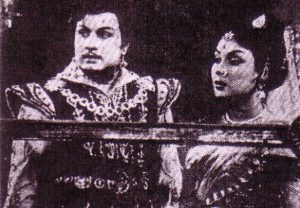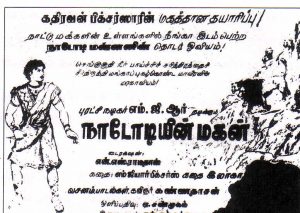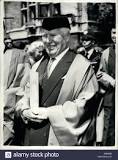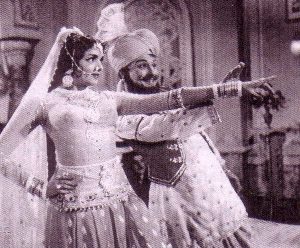Comparison of Chaplin and MGR
by Sachi Sri Kantha, December 9, 2018
Front Note
In the previous Part 46 covering the two MGR Pictures movies, ‘Nadodi Mannan’ (1958) and ‘Adimai Penn’ (1969), I had presented the emblem of MGR Pictures for the two movies. In the color emblem shown for ‘Adimai Penn’, there was his mentor Anna’s image in the flag, even when MGR was in the DMK party. MGR biographer and my friend R. Kannan pointed to me subsequently, that this was a later addition, after MGR had been expelled from the DMK party. I thank him, for this factual correction.
Chaplin and MGR

MGR and M.N.Rajam in ‘Nadodiyin Mahan’ (abandoned project)
Not many know that MGR had a plan for a sequel to the ‘Nadodi Mannan’ and did announce it as ‘Nadodiyin Mahan’ (Son of the Vagabond), under production around 1959. Subsequently, this sequel became an abandoned project. There have been numerous movie projects, other than ‘Nadodiyin Mahan’ first announced and then abandoned for political, financial and other reasons. This sequel was advertised as a ‘Kathiravan Pictures’ production, and directed by N.S. Ramadas. Story by MGR Pictures story department. Prominently, script and songs by Poet Kannadasan, was also announced. Ravindar’s memoirs also provide a still photo of MGR and M.N. Rajam, taken for this abandoned project. In this chapter, I make an attempt to provide one explanation for this abandoning pattern in MGR’s commitment, in comparison to that of movie pioneer Charlie Chaplin.
Previously I had compared the movie careers of MGR and Hollywood icon John Wayne (chapters 10, 11, 13 and 14) as well as MGR and an earlier generation Tamil superstar M.K. Thyagaraja Bhagavathar (chapter 24). In this chapter, I provide the comparison of the movie careers of MGR and another Hollywood icon Charlie Chaplin (1889-1977). Though superficially, it may appear that this sort of comparison may not do justice to both the actors, because while Chaplin was predominantly a silent movie star, MGR was a ‘talkie’ movie star. However, I venture in this exercise for two specific reasons: (1) This has not been attempted by MGR’s previous biographers and critics namely Chidanand das Gupta and Pandian. (2) There is much resemblance in the family background of poverty for both of them, passion to infuse political message in their movies, adulation of fans, controversy generated due to the award of honorary degree for both, carping ignoramus critics, professional perfection and respect they hold among their peers even decades after their death and the iconic status both hold now for Tamil movies (MGR) and Hollywood movies (Chaplin). In this series, I have passingly mentioned in previous chapters (20, 26, 28 and 30) such similarities between Chaplin and MGR.
Table – Comparison of career profile between Chaplin and MGR
Family Background of Chaplin and MGR
For reference, I provide a table that I prepared above, in which 16 parameters are compared for both actors. Chaplin (1889-1977) was 28 years senior to MGR (1917-1987), but both died within a 10 year span. Dec. 24th and Dec.25th of this month, marks the 31st 41st death anniversary of MGR and Chaplin respectively. For both, main humiliation during childhood and the reason for entry into stage career was family poverty. Both lost their fathers in their childhood. MGR lost his father, before he turned 3 Though Chaplin’s father died of natural causes when he was 12, he was an absentee father, to young Charlie. In his autobiography, Chaplin had noted the following facts:

‘Nadodiyin Mahan’ movie advertisement (circa 1959)
“What other facts besides drink were involved I do not know, but a year after my birth my parents separated.” Then, after his mother had been diagnosed as insane, Chaplin recorded, “I had seen him only twice in my life, on the stage, and once when passing a house in the Kensington Road, as he was coming down the front garden path with a lady. I had paused and watched him, knowing instinctively that he was my father. He beckoned me to him and asked my name. Sensing the drama of the situation, I had feigned innocence and said: ‘Charlie Chaplin’. Then he glanced knowingly at the lady, felt in his pocket and gave me half a crown…”
Both Chaplin and MGR had elder brothers, older to them by 4- 6 years. In Chaplin’s case, it was a step a brother Sydney, who was born illegitimately to his mother in a previous relationship with a guy named Sydney Hawkes. Later, he was given his stepfather’s surname. For MGR, Chakrapani was his own brother. Siblings of both Chaplin and MGR did appear in few of the movies featuring their famed younger brothers.
Cinematic Ideology
The ideology propagated by both Chaplin and MGR in their movies was similar – defense of the powerless against the authority figures. While Chaplin promoted this ideology using comedy as the genre, MGR’s genre was action-adventure type. A notable similarity was that the films of Chaplin and MGR cast suspicion upon authority figures in public affairs and business. That both Chaplin and MGR were blessed with courage of conviction was commendable. At a time, while most of Hollywood was being politically discreet when Hitler was at his prime in late 1930s, Chaplin made the anti-Nazi movie (his first talkie), the Great Dictator (1940) and poked fun at Hitler was a master stroke. Subsequently, Chaplin also tweaked the nose and pulled the legs of pompous authority figures representing Uncle Sam, in movies like, Monsieur Verdoux (1947) and A King in New York (1957) Similarly, MGR during his span of dominant movie phase (1950-1978), willingly sacrificed the range of character roles he would play by sticking to his principles of anti-alcohol use, anti-smoking and anti-violence against women was a meritorious act.
Controversy on the award of a Honorary Ph.D Degree

Chaplin’s honorary degree in 1962
Both Chaplin and MGR were awarded honorary Ph.D degrees for their contribution to the society at large, by the Oxford University and the Madras University in 1962 and 1983 respectively. And, as expected there was criticism from narrow minded ivory tower academics, editorialists and critics of cheapening the Ph.D degree. Chaplin’s degree was protested by few Oxford academics, including Hugh Trevor-Roper, Regius Professor of Modern History and an authority on Adolf Hitler. He had felt that the university was “demeaning itself by honouring a comic actor”. Conservative editorialists in the USA criticized this award, for equating Chaplin, to the status of Dean Rusk (1909-1994, ex U.S. Secretary of State who served Presidents Kennedy and Johnson), by the same honorary degree. Nevertheless, in hindsight, Chaplin’s single anti-Nazi film ‘The Great Dictator’ seems to achieve prestige with time and will certainly remain as a cinema masterpiece of the 20th century, compared to the tomes written by Hitler authority Hugh Trevor-Roper. Also the fact remains that there had been numerous U.S. Secretary of States in the 20th century, once in every four years – but only one Chaplin in the world.
When MGR was awarded the honorary Ph.D degree for his contribution to arts, by the University of Madras in 1983, there was ridicule by critics, some of whom had earned such a Ph.D degree from distinguished or mediocre-grade universities in India or elsewhere. To quote a footnote in Pandian’s 1992 monograph,
“The way in which MGR got his honorary doctorate was scandalous. The recipients of the honour were informed in advance by the University to enable them to get their academic gowns stitched in time. But the people responsible for selecting the candidates were kept in the dark. An hour before the convocation, the Vice Chancellor Dr N. Santappa, presented a list of eleven names to the University Senate and sought its approval. Not wanting to disrupt the convocation, the Senate approved the list after registering its protest over the manner in which it had been treated.”
The Vice Chancellor’s initial is mis-typed above. It was Mushi Santappa (1923-2017), an Indian polymer chemist and leather technologist.
Another MGR critic, Chidananda das Gupta, commenting on the same honorary Ph.D award given to MGR in 1983, wrote an year before,
“The cavils of critics notwithstanding, MGR was conferred a doctorate in law (honoris causa) of the Madras University on the occasion of its 125th Jubilee celebrations. Among others similarly honoured on the same occasion was world-famous astrophysicist S. Chandrasekhar of the University of Chicago…The list of 11 names was ratified at a special meeting of the Senate ‘convened under unprecedented haste’. Most of the members of the Senate and the Syndicate had not been informed of the meeting except by a newspaper advertisement published the previous day.”
Here, das Gupta somehow jabs at MGR’s qualification to receive an honorary Ph.D degree, by equating his record to that of the world renowned astrophysicist Subrahmanyam Chandrasekhar. This is simply a case of comparing apples and oranges. Whereas MGR may be clueless in astrophysics, Chandrasekhar was equally clueless in the stage craft of acting and associated skills. MGR’s versatility in movie making skills have been complimented even by his peers like Cho Ramaswamy. Whereas Chandrasekhar’s research papers and books are decipherable only to a minority among scientists (who are specialists in physics and astronomy), MGR’s movies and the message they preach to the society via songs reaches millions of Tamils. Even 30 years after MGR’s death, senior artistes who had worked with MGR, like actresses Sowcar Janaki (b. 1931), M.N. Rajam (b. 1940) and poet lyricist Muthulingam (b. 1942) to name a few, extol MGR’s all-round technical talent in movie making, language and literary skills in their media interviews, currently available in YouTube.
One may fault the secretive procedure adopted by the University of Madras authorities in announcing the honorary Ph.D award to MGR. But, like that of Chaplin and the Oxford University in 1962, whether MGR deserves a Ph.D or not for his elite status and contribution to the society at large via cinematic art form, is never in doubt, among Tamils.
The Question of being a Genius
This brings to the question of whether MGR was a genius. Millions of his fans will assert, sure he is. But, his critics will disagree totally. Now, there is a general consensus that, despite his character flaws (in dealing with women), Chaplin was a genius. Same with Picasso too. How about MGR?
First, let me define who is a genius. There are numerous definitions. A convenient one I could find, was that of Marvin Eisenstadt. He defined a genius as the development of an individual to a high degree of competency and superiority in an occupational field. This is postulated to be due to several criteria, including
- A certain degree of innate, biologically determined characteristics – principally intelligence, physical abilities and the like.
- Individual development of those capacities by a unique and specific psychological mechanism
- Training and educational advancement, leading to
- Accomplishment
Combination of these four criteria, which made both Chaplin and MGR to stand out and shine among their rivals and peers for over four decades demonstrated that they belong to genius grade. My contention is that critics like das Gupta and Pandian were snobs who failed to assess MGR’s success in cinema, comparatively. In both their works, I couldn’t find any single reference to MGR’s peers (as I have done in this series) in the cinemas of other cultures, even that of Hollywood. Das Gupta had only compared MGR with his junior contemporary N.T. Rama Rao (of Andhra Pradesh).
Aiming for Perfection
To the four criteria which I had mentioned above cited by Eisenstadt on the quality of a genius, I’d add ‘aiming for perfection’ is another important criterion in the work of a genius. I’d say, a focus on improving one’s creativity; that is, not to be satisfied with what is already in hand, and attempting to achieve a better artistic result (or output), even while being on top. This criterion resulted in numerous ‘abandoned projects’ in the oeuvre of Chaplin and MGR. The Chaplin Encyclopedia compiled by Glenn Mitchell, begins with a two page entry on ‘Abandoned Projects’. Chaplin had been toying with the idea of making a movie on Napoleon and subsequently abandoned it. Subsequently, he wanted to make a serious movie ‘Shadow and Substance’ as a vehicle to introduce his 4th wife Oona O’Neill. Later, this attempt was also abandoned.
Strangely enough, both Chaplin and MGR also had toyed with the idea of making a movie on Jesus Christ, both playing the character of Christ. Ravindar (who was one of MGR’s writing assistant, items 1-4 below), Tamil Piththan (poet Kannadasan’s assistant, items 5-8 below) and lyricist Vaali (item 9 below) had provided some details of MGR’s abandoned projects. These titles of movies include,
- Parama Pitha (‘Holy Father’) – Saravana Films
- Innaintha Kaigal (‘Joined Hands’)
- Kilaku Afrikavil Raju (‘Raju in East Africa’) – MGR Pictures
- Nadodiyin Mahan (‘Son of a Vagabond’)
- Uthama Puthiran (‘Perfect Son’) – Swaastik Films
- Maaveerar Maruthu Pandiyar (‘Great Hero Maruthu Pandiyan’)
- Bhavani (Bhavani)
- Oomaiyan Kottai (Fort of the Dumb)
- Unnai Vida Maataen (I won’t leave You)
According to Tamil Piththan, items 5 to 8 were planned for production by poet Kannadasan, and for multiple reasons, they were either given up at half way, or acting cast was changed and released under another name. For example,
announced Uthama Puthiran (no. 5) movie, starring MGR was given up by MGR himself, to avoid unnecessary conflict with Venus Picture’s production by the same name, starring Sivaji Ganesan. Oomaiyan Kottai (no. 8) was changed into ‘Sivagangai Seemai’ (starring SSR) and released in rivalry with Sivaji Ganesan’s biopic movie ‘Veera Pandia Kattabomman’.
Information on item 9 was culled from the memoirs of poet lyricist Vaali. This movie was scheduled for production, after MGR assumed the chief minister position in 1977, and given up after one month.4
Another aspect of aiming for perfection by a genius, is to learn a new technique or language on his own, rather than faking by using dupes or camera technique to conceal one’s imperfection. For his movie, The Circus (1928), Chaplin spent two months in learning high wire walking in his mid 30s.

MGR and L.Vijayalakshmi bangra dance in ‘Kudiyiruntha Kovil’
Similarly, as Ravindar and L. Vijayalakshmi had recorded for posterity, for the Bangra duet dance scene and song, ‘Aadaludan Paadalai kettu’ in the movie Kudiyiruntha Kovil (1968) with accomplished dancer Vijayalakshmi, MGR learnt bangra dance for one month, at the age of 51 (and most importantly after the 1967 shooting incident and rehabilitation!), before the ‘take’. This indicates the professional attitude MGR brought to his movie act. Even now, after 50 years, listening to that song and the dance performance of Vijayalakshmi and MGR in YouTube, makes one’s nerve tingle with a jingling melody, sung by T.M.Soundararajan and P. Suseela, set to tune by maestro M.S.Viswanathan, for Alangudi Somu’s lyric.
[check the song in YouTube https://www.youtube.com/watch?v=BqeX54Wmvgw]
In the words of Vijayalakshmi, “Bangra sequence was new to Tamil movies then. Chopraji master had introduced the dance to the State for the first time in that film. And that’s why it is still a superhit. On the shooting day, MGR watched me dancing and was horrified. ‘Ayyayoh…I cannot match Viji’s fast movements…’ he said, and withdrew.’
‘I saw him discussing something with Chopraji and the shooting was put off. The song sequence was shot after a month. I was told that MGR had practiced bangra for a month to dance with me. It seemed full of fun…Even today people sing this song whenever they see me…’ ”
MGR’s thoughts on how he approached this dance ‘take’ has been provided by Ravindar as follows: “… I also know dance. What I learnt in dance was helpful to me, for fighting [scenes]. For both, ‘steps’ are important. I have danced in movies like ‘Vikramathithan’ and ‘Mannathi Mannan’. One can cheat, by shots, if it’s Bharatha Natyam. But, in this dance, if the movement is missed, that will be a flop!’
Producer Velumani politely asked him [to reconsider his decision of learning the bangra dance]. Director K. Sankar also told him – ‘You are talking without confidence in your skill. I’ll take shots in such a way. If you don’t agree, we can leave it. You don’t have to dance, according to the instructions given by the dance master.’
MGR responded: ‘That’s wrong. When it comes to job, we need to recognize the professionals who are involved with it…I have a request. After the ‘take’ no one should see it. Only after I give my consent.’
It took three days to complete that dance sequence for that song [Note by Sachi: screen time was only 6 min]. Even, Vijayalakshmi was appreciative of MGR’s performance. ‘You have hidden me, in front of you!’ she told….At the end, MGR said, ‘a movie is like pregnancy. 3 months for a cat. 10 months for a woman. 3 years for an elephant. Depending on the quality of the movie, the time may vary.’
Sources
Charles Chaplin: My Autobiography, Bodley Head, London, 1964.
J Marvin Eisenstadt: Parental loss and genius. American Psychologist, 1978 Mar; 33: 211-223.
Steven Fielding: British politics and cinema’s historical dramas, 1929-1938. Historical Journal, 2013 Jun; 56(2): 487-511.
Harry A. Grace: Charlie Chaplin’s films and American culture patterns. Journal of Aesthetics and Art Criticism, 1952 Jun; 10(4): 353-363.
Michael Heffernan and Heike Jons: Degrees of influence: the politics of honorary degrees in the universities of Oxford and Cambridge, 1900-2000. Minerva, 2007; 45: 389-416.
Sowcar Janaki, Actress interview in Tamil, with Yamuna Kishore, available in YouTube https://www.youtube.com/watch?v=4CdQJFS0QQE (duration 25 min; accessed Dec. 8, 2018)
D.A.N. Jones: Chaplin and women. Grand Street, 1985 autumn; 5(1): 216-238.
Poet lyricist Muthulingam interview with Kavin, available in YouTube
https://www.youtube.com/watch?v=wIE82yIsqgU&t=303s (duration 1 hour; accessed Dec 8, 2018)
Glenn Mitchell: The Chaplin Encyclopedia, B.T.Batsford Ltd, London, 1997.
T.A. Narasimhan: MGR learnt bangra for month to dance with L. Vijayalakshmi. The Hindu (Chennai), Dec. 24, 2007.
M.S.S.Pandian: The Image Trap – M.G.Ramachandran and Film and Politics, SAGE Publications, New Delhi, 1992.
M.N. Rajam, Actress, at a 2015 felicitation function of Chennai Humor Club, available in youtube. https://www.youtube.com/watch?v=1yhz95Dhh-8 (total duration 2 hours, but the session with M.N. Rajam, begins after 1 hour; accessed Dec.8, 2018)
Ravindar (aka Kaja Muhaideen): Pon Mana Chemmal MGR, Vijaya Publications, Chennai, 2009.
David Robinson: Chaplin – His Life and Art, McGraw Hill Publishing Company, New York, 1985.
Tamil Pithan: Paatu Kuyil Kannadasan, Vanathi Pathipagam, Chennai, 1980.
It is amazing to learn more about MGR’s drive for perfection. Thanks Dr. Sachi for literally bringing alive the events leading to the shooting of his great bhangra dance!
Even as the chief minister, his welfare schemes which were meticulously planned are role models for schemes throughout India.
I do appreciate the comments of reader Arul.
In the sources listing, reference to das Gupta’s book have been inadvertently omitted. It is as follows:
Chidananda Das Gupta: The Painted Face – Studies in India’s Popular Cinema, Roli Books Pvt, Ltd, New Delhi, 1991.